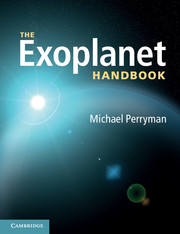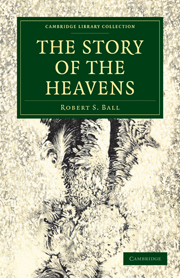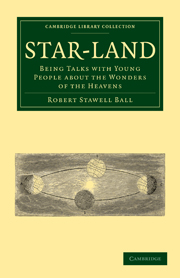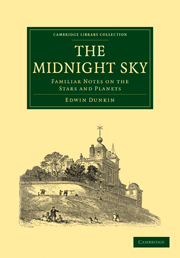Refine listing
Actions for selected content:
16950 results
1 - THE UNFINISHED REVOLUTION
-
- Book:
- The Living Cosmos
- Published online:
- 05 August 2011
- Print publication:
- 02 June 2011, pp 3-50
-
- Chapter
- Export citation
Contents
-
- Book:
- The Living Cosmos
- Published online:
- 05 August 2011
- Print publication:
- 02 June 2011, pp vii-xii
-
- Chapter
- Export citation
7 - ARE WE ALONE?
-
- Book:
- The Living Cosmos
- Published online:
- 05 August 2011
- Print publication:
- 02 June 2011, pp 264-310
-
- Chapter
- Export citation
3 - EXTREME LIFE
-
- Book:
- The Living Cosmos
- Published online:
- 05 August 2011
- Print publication:
- 02 June 2011, pp 93-137
-
- Chapter
- Export citation
NOTES
-
- Book:
- The Living Cosmos
- Published online:
- 05 August 2011
- Print publication:
- 02 June 2011, pp 311-340
-
- Chapter
- Export citation
5 - LIVING IN THE SOLAR SYSTEM
-
- Book:
- The Living Cosmos
- Published online:
- 05 August 2011
- Print publication:
- 02 June 2011, pp 182-221
-
- Chapter
- Export citation
6 - DISTANT WORLDS
-
- Book:
- The Living Cosmos
- Published online:
- 05 August 2011
- Print publication:
- 02 June 2011, pp 222-263
-
- Chapter
- Export citation
READING LIST
-
- Book:
- The Living Cosmos
- Published online:
- 05 August 2011
- Print publication:
- 02 June 2011, pp 353-360
-
- Chapter
- Export citation
GLOSSARY
-
- Book:
- The Living Cosmos
- Published online:
- 05 August 2011
- Print publication:
- 02 June 2011, pp 341-352
-
- Chapter
- Export citation
THE LIVING COSMOS
-
- Book:
- The Living Cosmos
- Published online:
- 05 August 2011
- Print publication:
- 02 June 2011, pp 1-2
-
- Chapter
- Export citation
MEDIA RESOURCES
-
- Book:
- The Living Cosmos
- Published online:
- 05 August 2011
- Print publication:
- 02 June 2011, pp 361-362
-
- Chapter
- Export citation
INDEX
-
- Book:
- The Living Cosmos
- Published online:
- 05 August 2011
- Print publication:
- 02 June 2011, pp 369-393
-
- Chapter
- Export citation
2 - LIFE'S ORIGINS
-
- Book:
- The Living Cosmos
- Published online:
- 05 August 2011
- Print publication:
- 02 June 2011, pp 51-92
-
- Chapter
- Export citation
ILLUSTRATION CREDITS
-
- Book:
- The Living Cosmos
- Published online:
- 05 August 2011
- Print publication:
- 02 June 2011, pp 363-368
-
- Chapter
- Export citation
Frontmatter
-
- Book:
- The Living Cosmos
- Published online:
- 05 August 2011
- Print publication:
- 02 June 2011, pp i-vi
-
- Chapter
- Export citation
PREFACE
-
- Book:
- The Living Cosmos
- Published online:
- 05 August 2011
- Print publication:
- 02 June 2011, pp xv-xviii
-
- Chapter
- Export citation

The Exoplanet Handbook
-
- Published online:
- 01 June 2011
- Print publication:
- 26 May 2011

The Story of the Heavens
-
- Published online:
- 01 June 2011
- Print publication:
- 26 August 2010
- First published in:
- 1885

Star-Land
- Being Talks with Young People about the Wonders of the Heavens
-
- Published online:
- 01 June 2011
- Print publication:
- 03 June 2010
- First published in:
- 1889

The Midnight Sky
- Familiar Notes on the Stars and Planets
-
- Published online:
- 01 June 2011
- Print publication:
- 26 August 2010
- First published in:
- 1869
